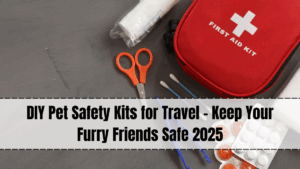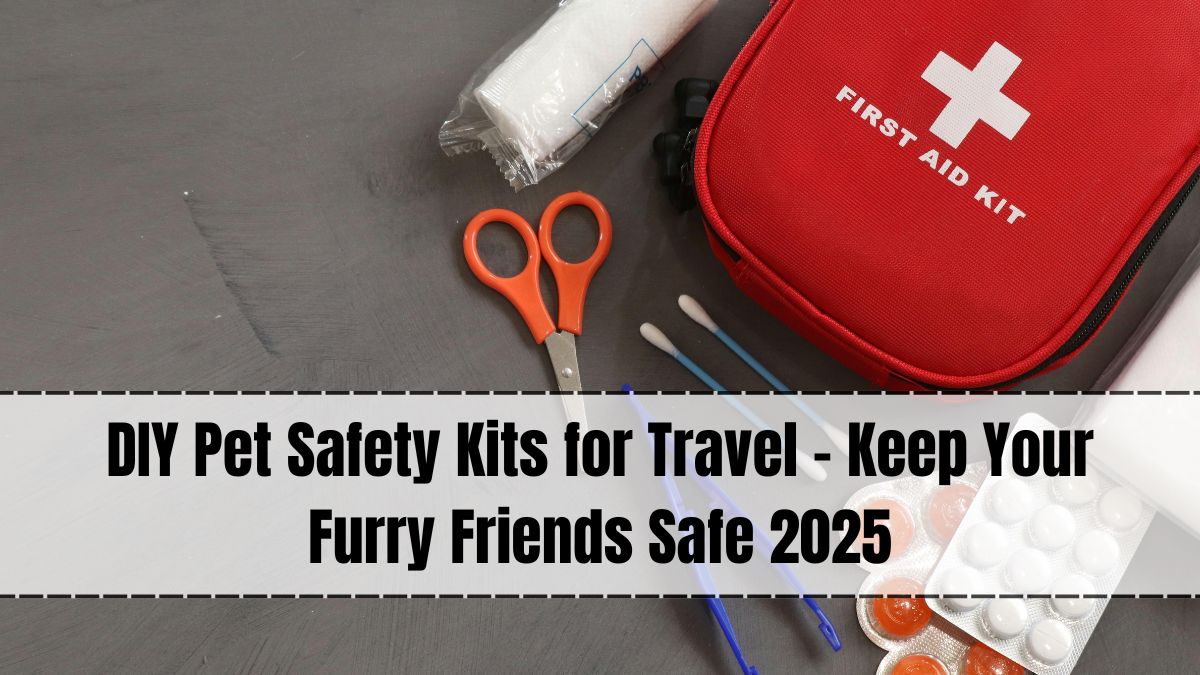In 2025, more pet owners are traveling with their furry companions than ever before, thanks to the growing popularity of pet-friendly destinations, accommodations, and transport options. Whether it’s a weekend road trip, a train journey, or an international flight, ensuring your pet’s safety and comfort during travel is a top priority. A well-prepared DIY pet safety kit can make all the difference, providing essential items to handle emergencies, maintain hygiene, and keep your pet comfortable throughout the trip. By customizing the kit to your pet’s specific needs, you can travel with confidence knowing that you are ready for any situation.

Why a Pet Safety Kit is Essential for Travel
Travel can be stressful for pets due to unfamiliar environments, noise, and changes in routine. Having a dedicated pet safety kit ensures that you have all necessary supplies on hand to address health concerns, manage behavior, and maintain comfort. Emergencies such as sudden illness, minor injuries, or dehydration can arise at any time. A well-stocked kit acts as your first line of defense, allowing you to respond quickly without depending solely on local stores or veterinary services, which might not always be readily accessible.
Core Components of a DIY Pet Safety Kit
A good DIY pet safety kit should include a mix of medical supplies, comfort items, and travel essentials. Key components often include a basic first-aid kit with antiseptic wipes, gauze pads, adhesive bandages, and pet-safe antiseptic spray. Include a digital thermometer, tweezers for tick removal, and any prescribed medications your pet regularly takes. Hydration is vital, so pack a collapsible water bowl and bottled water. A portion of your pet’s regular food in a sealed container ensures dietary consistency, preventing digestive upsets. For cleanliness, carry waste bags, grooming wipes, and a small towel.
Comfort and Stress Management Items
In addition to medical and hygiene supplies, your kit should contain items that help your pet feel safe and secure. Familiar blankets, toys, or even a piece of your clothing can provide comfort by carrying a familiar scent. Calming sprays or treats made with natural ingredients like chamomile or CBD (where legally allowed) can help reduce travel anxiety. A portable crate or carrier with proper ventilation and padding provides a secure space for rest during transit, especially for cats and small dogs. Including a leash, harness, and reflective tags ensures safety during walks or emergency situations.
Customizing the Kit for Your Pet’s Needs
Every pet is unique, so customizing the kit according to your pet’s breed, size, health, and temperament is important. For example, brachycephalic breeds like pugs or Persian cats may require cooling mats or portable fans to prevent overheating. Senior pets might benefit from joint supplements or orthopedic bedding for extra comfort. If you’re traveling to areas with extreme weather, adjust your kit to include items like dog boots for hot pavements or thermal blankets for colder climates. For pets with allergies, pack hypoallergenic food and any emergency allergy medication prescribed by a vet.
Travel-Specific Additions
The type of travel you’re undertaking will influence what goes into your pet safety kit. For car trips, include a seat belt harness or booster seat for dogs, and ensure the carrier is securely strapped in. For air travel, comply with airline-specific requirements, which may include absorbent bedding, water dispensers, and clear identification labels. Train journeys might call for more compact kits and easy-to-carry carriers. For camping or hiking trips, include tick repellents, portable paw washers, and a flashlight with extra batteries for nighttime visibility.
Safety and Identification Measures
Proper identification is a crucial part of pet safety. Ensure your pet’s collar has an ID tag with your current contact information. Microchipping is highly recommended, and your pet’s microchip details should be up to date before travel. For added safety, carry printed copies of your pet’s vaccination records, medical history, and a recent photograph in case they get lost. Some pet owners also use GPS-enabled smart collars to track their pet’s location in real time, which can be especially helpful in unfamiliar environments.
DIY Tips for Assembling the Kit
Assembling your own kit allows you to tailor it to your pet’s specific needs while also saving money compared to pre-packaged options. Use a durable, waterproof bag or backpack with multiple compartments to organize items efficiently. Label each section clearly—for example, “First Aid,” “Food & Water,” and “Comfort Items.” Replenish perishable items like treats and medications before each trip, and review the contents regularly to ensure nothing is expired or damaged. Keep the kit easily accessible during travel so you can reach it quickly if needed.
Benefits of a DIY Pet Safety Kit
Creating your own pet safety kit not only ensures your pet’s well-being but also provides peace of mind for you as the owner. You’ll have immediate access to essential supplies, reducing stress during emergencies. It also promotes self-sufficiency, as you won’t have to rely on unfamiliar local stores that may not stock what you need. A DIY approach allows for customization that pre-made kits cannot match, ensuring that every item serves a purpose for your pet’s unique requirements.
The Future of Pet Travel Safety
By 2025, technology has also enhanced pet travel safety. Wearable health monitors can track your pet’s heart rate, temperature, and activity levels, sending alerts to your smartphone if something is wrong. Smart feeding devices ensure consistent meal schedules, and AI-powered pet travel apps can recommend pet-friendly stops and veterinary clinics along your route. Combining these advancements with a well-prepared DIY safety kit ensures your pet has the safest, most comfortable travel experience possible.
FAQs
What should be included in a basic pet safety kit?
It should have first-aid supplies, food, water, comfort items, waste disposal bags, and any necessary medications.
How often should I update my pet safety kit?
Review and update it before every trip, replacing expired items and adjusting contents for the season and destination.
Can I buy a pre-made kit instead of making one?
Yes, but DIY kits are often better because they can be customized to your pet’s specific needs.
Is a pet safety kit necessary for short trips?
Yes. Even short trips can have unexpected delays or emergencies, so having basic supplies on hand is always wise.
Click here to know more.
